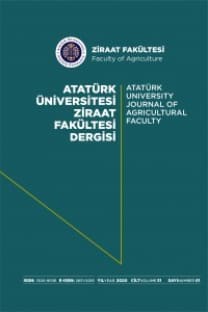Keçiboynuzunun Genç ve Olgun Yapraklarından DNA Ekstraksiyonu İçin Dört Farklı Protokolün Değerlendirilmesi
Keçiboynuzu, genetic çeşitlilik, DNA, moleküler markır
Evaluation of Four Different Protocols for DNA Extraction from Young and Old Carob Leaves
Carob, genetic diversity, DNA, molecular marker,
___
- Akinnagbe O. M., Onah C. P., Olaolu, M. O., Ajayi, A. R., 2012. Farmers’ perception of the impact of climate change on agricultural activities in Otukpo local government area of Benue State, Nigeria. In: Proceedings of the 17th Annual National Conference AESON, 11 –14 March, 2012, pp109-117, Nsukka, Nigeria. Aubakirova, K., Omasheva, M., Ryabushkina, N.,Tazhibaev, T., Kampitova, G., Galiakparov, N., 2014. Evaluation of five protocols for DNA extraction from leaves of Malus siever, Vitis vinifera, and Armeniaca vulgaris. Genet. Mol. Res. 13 (1): 1278-1287. Ausubel, F. M., Brent, R., Kingston, R.E., Moore, D.D., Seidman, J.G., Smith. J.G. et al., 2002. Short Protocols in Molecular Biology: a compendium of methods from Current Protocols in Molecular Biyology, vol. 2,Wiley, New York, NY. Balik, J., Kyseláková, M., Vrchotová, N., Tríska, J., et al. 2008.Relations between polyphenols content and antioxidant activity in vine grapes and leaves. Czech J. Food Sci. 26: S25-S32 Barracosa, P., Almeida, M.T., Cenis, J., 1996. Characterization of cultivars of carob tree in Algarve (Portugal). In: Proceeding of the III International Carob Symposium. Cabanas-Tavira, Portugal Batlle, I.M., Tous, R.J., 1997. Carob germplasm characterization using izozymes. In: Proceeding of the III International Carob Symposium. Cabanas-Tavira, Portugal. Bushra, C., Afshan, Y., Tayyab, H., Riazuddin, S., 1999. Mini-scale genomic DNA extraction from cotton. Plant Mol. Biol. Rep., 17: 1–7. Carlson, W.A., 1986. carob: evaluation of trees, pods and kernels. Int. Tree Crops J., 3 (1986), pp. 281–290 Casıva, P.V., Saidman, B. O., Vılardı, J. C., Cıaldella, A.M., 2002. First comparative phonetic studies of Argentinean species of Acacia (Fabaceae), using morphometric, isozymal and RAPD approaches. AmericanJournal of Botany 89(5): 843–853. Crouch, H.K,. Crouch, J.H., Madsen, S., Vuylsteke, D.R., Ortız, R., 2000. Comparative analysis of phenotypic andgenotypic diversity among plantain landraces (Musa spp., AAB group). Theor. Appl. Genet, 101:1056–1065 Dellaporta, S.L., Wood, J., Hicks, J.B., 1983. A plant DNA mini preparation: Version II. Plant Mol. Bio. Rep. 1: 19-21. Doyle, J.J., Doyle, J.L., 1990. Isolation of plant DNA from fresh tissue. Focus 12: 13-15. Edwards, K., Johnstone, C.,Thompson. C., 1991. A simple and rapid method for the preparation of plant genomic DNA for PCR analysis. Nucleic Acids Res. 19: 1349. Emberger, L., Maire, R., 1941. Cataloguedes plantes du Maroc.Volume IV. Minerva, Alger. Garcia, M. G., . Ontivero, M., J. Dıazrıccı, C., Castagnaro, A., 2002. Morphological traits and high resolution RAPD markers for the identification of the main strawberry varieties cultivated in Argentina. Plant Breeding 121, 76-80. Gharnit, N., El Mtili, N., Ennabili, A., Sayah, F., 2004. Floral characterization of carob tree (Ceratonia siliqua L.) from the province of Chefchaouen (NW of Morocco). Moroccan J. Biol., 1pp. 41–5 Guillemaut, P., and Maréchal-Drouard, L., 1992. Isolation of plant DNA: a fast, inexpensive and reliable method. Plant Mol. Biol. Rep. 10: 60-65. Güzeldağ, G.,. Çolak, Õ., 2007. Molecular identification of Ganoderma lucidm from Turkey. Int. J. Agric. Biol., 9: 767–770. Halliwell, B., 1990. How to characterize a biological antioxidant. Free Radic. Res. Commun. 9: 1-32. Jobes, D.V., Hurley, D.L., Thien, L.B., 1995. Plant DNA isolation: a method to efficiently remove polyphenolics, polysaccharides and RNA. Taxon 44: 349-386. Konate, I., Berraho, E.B., Filali-Maltouf, A., 2009. Inter-simple sequence repeat markers variation among natural accessions of Moroccan Carob Tree (Ceratonia siliqua L.), Inter. J. of Agri.Biol., 11: 168-172. Konaté, I., Filali-Maltouf, A., Berraho, E., 2007. Diversity analysis of Moroccan carob (Ceratonia siliqua L.) accessions using phenotypic traits and RAPD markers, Acta Bot. Malacitana, 32: 79–90. Kulkarni M, Borse, T., Chaphalkar, S., 2001.Isolation and purification of genomic DNA from black plum (Eugenia jambolana Lam.) for analytical applications. Int. J. Biotechnol. Biochem. 3: 49-55. Lodhi, M.A., Ye, G.N., Weeden, N.F., Reisch, B.I., 1994. A simple and efficient method DNA extraction from grapevine caltivars and vitis species. Plant Mol. Biol. Rep., 12: 6–13. Morsy, A.A., 2007. Molecular variation of Achillea fragrantissima (Forssk.) SCH. BIP. Growing in five areas of South Sinai. Int. J. Agric. Biol., 9: 11–17 Ounzar, B., Hartmann, C., Rode, A., Benslimane, A., 1998. Date palm DNA minipreparation without liquid nitrogen. Plant Mol. Rep. 16: 263-269. Samal S., Rout, G.R., Lenkaet, P.C., -2003- Analysis of genetic relationships between populations of cashew (Anacardium occidentale L.) by using morphological characterisation and RAPD markers. Plant Soil Environ. 49, (4): 176-182. Samarakoon, T., Wang, S.Y., Alford, M.H., 2013. Enhancing PCR amplification of DNA from recalcitrant plant specimens using a trehalose-based additive. Appl. Plant Sci. 1: 1200236. Sytsma, K., Givnish, T.J., Simt, J.F., Hahn, W.J., 1993. Collection and Storage of Land Plant Samples for Macromolecular Comparisons. In: Methods in Enzymology - Molecular Evolution: Producing the Biochemical Data (Zimmer EA, White TJ, Cann RL and Wilson AC, eds.). Academic Press, San Diego, 23-38. Talhinhas, P., Neves-Martins, J., Leilâo, J., 2003. AFLP, ISSR and RAPD markers reveal high levels of genetic diversity among Lupinus spp. Plant Breed., 122: 507–510. Tous, J., Batlle, I., 1990. In: El Algarrobo (Ed). Mundi-Prensa, Madrid. Tous,J., 1992. Isozyme polymorphism in carob cultivars Hort. Sci., 27 (1992), pp. 257–258 Weishing, K., Nybom, H., Wolff, K., Meyer, W., 1995. DNA isolation and purification. In: DNA fingerprinting in plants and fungi, pp 44-59. CRC Press, Boca Raton, Florida.
- ISSN: 1300-9036
- Yayın Aralığı: Yılda 3 Sayı
- Yayıncı: AVES Yayıncılık
Tüketicilerin Maraş Tarhanası Tüketim Davranışlarının Belirlenmesi; Kahramanmaraş İli Örneği
Emine İKİKAT TÜMER, Osman Doğan BULUT, Eda ŞEKER
Sürdürülebilir Tarım Açısından Türkiye’de Tohumculuk Sektörü
Adem AKSOY, Nuray DEMİR, Mehmet Muhammed SARI
Kentsel Peyzaj İçinde Mezarlıklar Ve Peyzaj Mimarlığı Açısından İncelenmesi; Nevşehir Örneği
Esra ÖZHANCI, Meliha AKLIBAŞINDA
Kuzgun Barajı Sulama Alanında Agro-Ekolojik Sınırlar ve Arazi Kullanım Planlaması
Yasemin KUŞLU, Üstün ŞAHİN, Fatih Mehmet KIZILOĞLU, Mustafa OKUROĞLU
Hasan Pinar, Mehmet YAMAN, Hakan KELEŞ, Mustafa ÜNLÜ, Ömer Faruk COŞKUN
Sürdürülebilir Tarım Açısından Türkiye'de Tohumculuk Sektörü
Mehmet Muhammed SARI, Nuray DEMIR, Adem AKSOY, H. Çağlar KAYMAK
KENTSEL PEYZAJ İÇİNDE MEZARLIKLAR ve PEYZAJ MİMARLIĞI AÇISINDAN İNCELENMESİ; NEVŞEHİR ÖRNEĞİ
